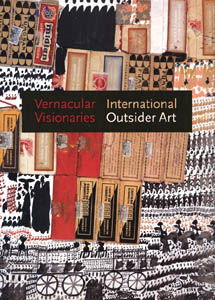|
Vernacular Visionaries: International Outsider Art leaves you frustrated with the state of the outsider art field -- not because of flaws in the book, which is outstanding, but because this intriguing show, which runs through August 29 at the Museum of International Folk Art, in Santa Fe, could not find venues to travel to. The catalog's quality is attributable to Annie Carlano's curatorial effort behind it, to her explicit intention not to be encyclopedic, and to a book design that does justice to the material. An in-depth focus on a few artists allows for thoughtful treatment of each, with generously scaled and well-chosen illustrations demonstrating the virtues of the show's frank emphasis on connoisseurship. The essays are less consistent in quality than the connoisseurship, unfortunately -- a common enough problem in outsider art anthologies, where lightly researched anecdotes and terminological rehashes too often prevail. Still, the focus here tilts toward biographical and historical information, and most of the authors manage solid insights into the art. The fact that this international group of artists includes several whose work has not been widely exposed in the United States makes the essays helpful and the reproductions, at times, revelatory. The catalog is a good introduction to Gedewon, Hung Tung and Anna Zemánková, and John Maizels' essay on Nek Chand manages to shed some new light even on this well-known Indian artist. The Carlo Zinelli text, though informative, falls flat, and William Hawkins and Charlie Willeto have already been the subjects, in English, of the kind of monograph that each of these artists deserve. Of all the essays, Randall Morris' consideration of Martin Ramirez goes the furthest in using biography to uncover core artistic issues. Morris rightly emphasizes the presence of traditional cultural images throughout Ramirez's work, which is hardly indicative of the hermetically sealed universe of schizophila cliché. Even in the most objectively "brut" art there is reference to culture, and this is obvious from a cursory viewing. That it is necessary to make this point at all shows how difficult it is for those following Jean Dubuffet to distinguish between big "C" and little "c" when they read the word culture (big "C" referring to the high-art culture that was the primary object of Dubuffet's scorn). The research into Ramirez that Morris recounts is more than icing on the cake, since it begins to explain the artist's references and antecedents. His brief summary in this volume serves as a teaser for the fuller deciphering that one hopes is to come. Morris is on less solid ground, though, when he labels Ramirez's artistry vernacular. It is in line with the show's categorization of all these creators, but does an artist's use of popular images and traditions justify labeling him vernacular? If it did, then Andy Warhol, Mike Kelly, and Jeff Koons would all be vernacular artists. If the presence of vernacular images is not enough, what is it that makes Ramirez, or the other artists in this collection, vernacular? In fact, it is specifically the non-vernacular, highly personal elements of theirs visions and styles that most distinguish their work. "Vernacular" may be the latest fashionable labeling alternative for those squeamish about the insinuations of past names du jour. But before the term is degraded into another unsatisfying euphemism for outsider, self-taught, or whatever, let's consider its actual meaning. Art that is clearly vernacular is characterized by the dominance (not merely the presence) of language, formats, references, and raw materials that are in wide use in popular, as opposed to artistic, circles. It has its own value, but it does a disservice to both true vernacular artists and true artists brut to lump them all together. Fortunately, even when that happens, as in this instance when the work is presented under a misnomer, the quality of the art can easily overcome any issues with labeling.
A version of this review originally appeared in The Outsider magazine, published by Intuit: The Center for Intuitive and Outsider Art.
|
The Latest Stuff | Roadside art | Outsider pages | The idea barn | About | Home
Copyright Interesting Ideas 2004
